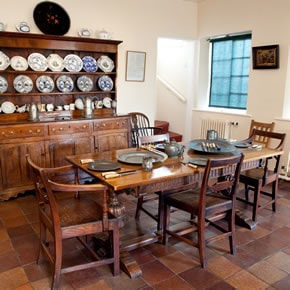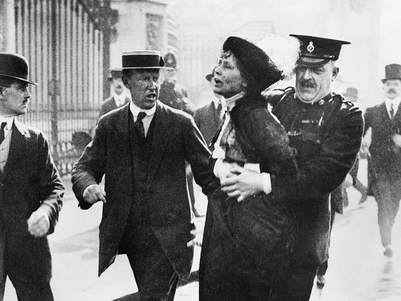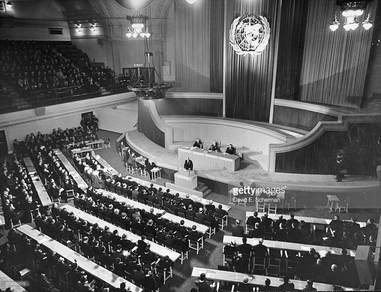Where should I start my Methodist Pilgrimage?

I've been looking at places I would mark on a map if I were to create a Methodist Pilgrimage route. Thankfully as soon as I started looking I found the Methodist Heritage Sites website and their extremely helpful google map.
I expect top of peoples lists would be Epworth Rectory. This was the home of the Reverend Samuel Wesley and his wife Susanna and of course Charles, Samuel and John along with their seven sisters, Samuel was the Rector at the nearby Anglican Church from 1685 until his death in 1735. The house was bought by the Methodist Church in 1954 with donations from Methodists across the world and has been extensively restored and is open to the public.
The site of the Wesley’s conversion at Aldersgate is also a very moving place to visit, unlike visiting a Cathedral or huge Church here is a very personal illustration of how Methodism came about, John’s “heart strangely warmed”.
John Wesley travelled extensively and there are many plaques erected to commemorate his preaching. As he was frequently banned from preaching inside the churches he would preach in the open air, often in the market places, or just outside the boundaries of the local church, often catching the congregations as they left worship. He even stood on his own father’s tombstone and preached. This is another helpful tool on the Methodist Heritage site, after all trying to find the exact tree or hill or steps where John stopped to preach is quite difficult. But then it also reflects our Methodist heritage. Out there, meeting the people where they are, helping those who need help, treating everyone as equals, both rich and poor.
One place I have visited several times is the little Methodist Chapel in Winchelsea East Sussex. John Wesley first visited Winchelsea in 1771, when he returned a few years later he found they had built their own preaching house and for a change he was able to preach inside however by the time he returned in 1790 ,just six months before his death, there were too many in the congregation to fit into the little preaching house and so he had to preach outside under an Ash tree. I was privileged and quite excited to stand in the very pulpit he preached from.
As a Local Preacher I have the privilege of visiting lots of different churches in my Circuit and it doesn’t matter whether there are 10 or 60 members in the congregation there is always a feeling of belonging and of love. Recently I preached in an Anglican/Methodist Church with 8 people, an organist, me and a dog. The building was a traditional Anglican Church (1634) with stained glass windows, wooden pews and cold, it was however beautiful. Each church and congregation has its own individuality and it is reflected not only in the building but in the people and communities who are part of it.
The great thing about Methodist buildings are that they are incredibly versatile. Most buildings have been designed to be multipurpose and can accommodate many activities on the premises at the same time.
Our church building for instance has a Pre-School in the hall, small groups for mothers and toddlers and music groups in our coffee area and choir groups using our church during the week to practice and our young people meet in a newly decorated room with widescreen tv’s and leather sofas. Because the buildings are no longer just places of worship more and more people are using them, the local community as well as the church and they are becoming the hub of the community once again.
Methodist Central Hall in Westminster is the most versatile building I have come across, but it hasn’t lost its identity as a place of worship. The building was purpose built and opened on 3rd October 1912. The cost of the building was covered by what was known as the 20th Century Fund. I love how donations of one guinea were requested, no one could give more than one guinea, which meant that everyone had a sense of equality in funding this amazing building. Each donation was recorded in the Historic Roll, 50 red leather-bound books, these are available for viewing.
The vastness of this building has meant that over the years many memorable meetings have taken place there. The Suffragette movement held a rally there in 1914 during their campaign for votes for women. The very first meeting of the General Assembly of the United Nations met there in 1946. World leaders, scientists, philanthropists, people from many different religious backgrounds have all addressed gatherings in this building among them Mahatma Gandhi and General De Gaulle.
During his first service at Methodist Central Hall Reverend William Sangster was interrupted with the news that War had been declared. Shortly after that he arranged for the basement of the building to be used as an air raid shelter. For 1688 days 2000 Londoners took refuge along with the Reverend William Sangster and his family. The building came through the war unscathed. To this day it continues to be used by the communities around it, different groups led by various denominations provide support for homeless, for immigrants for Mothers and children.
As well as a place of Worship the building is being used for conferences, wedding venues, it has hosted several televised Cross-Party Debates and been the seat of several high-profile enquiries. The BBC has used it on numerous occasions to host shows and concerts, recently Songs of Praise was recorded from within the Great Hall and it has also been used in some big budget movies.
This is what it says on the Methodist Central Hall website “this money was allocated to the building of a 'monumental Memorial Hall' that would not only house a worshipping congregation and the headquarters of the then Wesleyan Methodist Church but would also be a meeting place for all people, regardless of religious persuasion. It was also to be of 'great service for conferences on religious, educational, scientific, philanthropic and social questions “
I think that the design of this building and the purpose for which it was to be used have far exceeded expectations. It is both beautiful and spiritual, it is a reflection of my Methodist heritage. It is as beautiful as any Cathedral or Abbey, even more so because it feels like a small intimate Chapel despite its vastness.
You can go and look at London from the rooftop, take in a concert- the Premier of Joseph and his Amazing Technicolor Dreamcoat was performed here in 1968 and recently a concert by Ed Sheeran. It has been the venue for sports events and part of London Fashion Week ,Some of the early meetings of what became known as the Suffragette Movement took place here at Methodist Central Hall in 1914,
re-enacted in the 2015 film ‘Suffragette’, some of which was shot here. This is such an amazing building and well worth a visit. Why not have lunch at the Wesley Café and relax.
Bibliography
Methodist Heritage Site http://www.methodistheritage.org.uk/heritagesites.htm
The Old Rectory Epworth http://www.methodistheritage.org.uk/theoldrectory.htm
Aldersgate-Conversions http://www.methodist.org.uk/about-us/the-methodist-church/history/the-conversions/
Download copy of Preface to the Letter
of St Paul to the Romans http://www.rivermethodistchurch.org.uk/uploads/1/8/3/1/18315667/martin-luther-preface-to-the- letter-of-st.-paul-to-the-romans1.pdf
Winchelsea Historic Methodist Church http://www.whmc.btck.co.uk/
Reverend William Sangster https://methodist-central-hall.org.uk/revd-william-e-sangster/
Virtual Tours of Central Hall https://www.c-h-w.com/chwgallery/virtualtours/
Pictures
The Old Rectory http://www.methodistheritage.org.uk/theoldrectory.htm
The First Meeting of the General Assembly
of the United Nations. 1936
https://www.google.co.uk/urlsa=i&rct=j&q=&esrc=s&source=images&cd=&cad=rja&uact=8&ved=0ahUKEwjFoJLR0b_ZAhVJLsAKHbC8A4QQjRwIBw&url=https%3A%2F%2Fwww.gettyimages.co.uk%2Fevent%2Fjan-un-general-assembly-meets-for-first-time-in-london-54996811&psig=AOvVaw387UB0WSenZ9lQaYD6NwTE&ust=1519599004372472
Suffragettes
https://methodist-central-hall.org.uk/vote100-suffragette-movement-methodist-central-hall/
2015 Film Suffragettes, some of the scenes were recreated at Central Hall
https://youtu.be/056FI2Pq9RY
I expect top of peoples lists would be Epworth Rectory. This was the home of the Reverend Samuel Wesley and his wife Susanna and of course Charles, Samuel and John along with their seven sisters, Samuel was the Rector at the nearby Anglican Church from 1685 until his death in 1735. The house was bought by the Methodist Church in 1954 with donations from Methodists across the world and has been extensively restored and is open to the public.
The site of the Wesley’s conversion at Aldersgate is also a very moving place to visit, unlike visiting a Cathedral or huge Church here is a very personal illustration of how Methodism came about, John’s “heart strangely warmed”.
John Wesley travelled extensively and there are many plaques erected to commemorate his preaching. As he was frequently banned from preaching inside the churches he would preach in the open air, often in the market places, or just outside the boundaries of the local church, often catching the congregations as they left worship. He even stood on his own father’s tombstone and preached. This is another helpful tool on the Methodist Heritage site, after all trying to find the exact tree or hill or steps where John stopped to preach is quite difficult. But then it also reflects our Methodist heritage. Out there, meeting the people where they are, helping those who need help, treating everyone as equals, both rich and poor.
One place I have visited several times is the little Methodist Chapel in Winchelsea East Sussex. John Wesley first visited Winchelsea in 1771, when he returned a few years later he found they had built their own preaching house and for a change he was able to preach inside however by the time he returned in 1790 ,just six months before his death, there were too many in the congregation to fit into the little preaching house and so he had to preach outside under an Ash tree. I was privileged and quite excited to stand in the very pulpit he preached from.
As a Local Preacher I have the privilege of visiting lots of different churches in my Circuit and it doesn’t matter whether there are 10 or 60 members in the congregation there is always a feeling of belonging and of love. Recently I preached in an Anglican/Methodist Church with 8 people, an organist, me and a dog. The building was a traditional Anglican Church (1634) with stained glass windows, wooden pews and cold, it was however beautiful. Each church and congregation has its own individuality and it is reflected not only in the building but in the people and communities who are part of it.
The great thing about Methodist buildings are that they are incredibly versatile. Most buildings have been designed to be multipurpose and can accommodate many activities on the premises at the same time.
Our church building for instance has a Pre-School in the hall, small groups for mothers and toddlers and music groups in our coffee area and choir groups using our church during the week to practice and our young people meet in a newly decorated room with widescreen tv’s and leather sofas. Because the buildings are no longer just places of worship more and more people are using them, the local community as well as the church and they are becoming the hub of the community once again.
Methodist Central Hall in Westminster is the most versatile building I have come across, but it hasn’t lost its identity as a place of worship. The building was purpose built and opened on 3rd October 1912. The cost of the building was covered by what was known as the 20th Century Fund. I love how donations of one guinea were requested, no one could give more than one guinea, which meant that everyone had a sense of equality in funding this amazing building. Each donation was recorded in the Historic Roll, 50 red leather-bound books, these are available for viewing.
The vastness of this building has meant that over the years many memorable meetings have taken place there. The Suffragette movement held a rally there in 1914 during their campaign for votes for women. The very first meeting of the General Assembly of the United Nations met there in 1946. World leaders, scientists, philanthropists, people from many different religious backgrounds have all addressed gatherings in this building among them Mahatma Gandhi and General De Gaulle.
During his first service at Methodist Central Hall Reverend William Sangster was interrupted with the news that War had been declared. Shortly after that he arranged for the basement of the building to be used as an air raid shelter. For 1688 days 2000 Londoners took refuge along with the Reverend William Sangster and his family. The building came through the war unscathed. To this day it continues to be used by the communities around it, different groups led by various denominations provide support for homeless, for immigrants for Mothers and children.
As well as a place of Worship the building is being used for conferences, wedding venues, it has hosted several televised Cross-Party Debates and been the seat of several high-profile enquiries. The BBC has used it on numerous occasions to host shows and concerts, recently Songs of Praise was recorded from within the Great Hall and it has also been used in some big budget movies.
This is what it says on the Methodist Central Hall website “this money was allocated to the building of a 'monumental Memorial Hall' that would not only house a worshipping congregation and the headquarters of the then Wesleyan Methodist Church but would also be a meeting place for all people, regardless of religious persuasion. It was also to be of 'great service for conferences on religious, educational, scientific, philanthropic and social questions “
I think that the design of this building and the purpose for which it was to be used have far exceeded expectations. It is both beautiful and spiritual, it is a reflection of my Methodist heritage. It is as beautiful as any Cathedral or Abbey, even more so because it feels like a small intimate Chapel despite its vastness.
You can go and look at London from the rooftop, take in a concert- the Premier of Joseph and his Amazing Technicolor Dreamcoat was performed here in 1968 and recently a concert by Ed Sheeran. It has been the venue for sports events and part of London Fashion Week ,Some of the early meetings of what became known as the Suffragette Movement took place here at Methodist Central Hall in 1914,
re-enacted in the 2015 film ‘Suffragette’, some of which was shot here. This is such an amazing building and well worth a visit. Why not have lunch at the Wesley Café and relax.
Bibliography
Methodist Heritage Site http://www.methodistheritage.org.uk/heritagesites.htm
The Old Rectory Epworth http://www.methodistheritage.org.uk/theoldrectory.htm
Aldersgate-Conversions http://www.methodist.org.uk/about-us/the-methodist-church/history/the-conversions/
Download copy of Preface to the Letter
of St Paul to the Romans http://www.rivermethodistchurch.org.uk/uploads/1/8/3/1/18315667/martin-luther-preface-to-the- letter-of-st.-paul-to-the-romans1.pdf
Winchelsea Historic Methodist Church http://www.whmc.btck.co.uk/
Reverend William Sangster https://methodist-central-hall.org.uk/revd-william-e-sangster/
Virtual Tours of Central Hall https://www.c-h-w.com/chwgallery/virtualtours/
Pictures
The Old Rectory http://www.methodistheritage.org.uk/theoldrectory.htm
The First Meeting of the General Assembly
of the United Nations. 1936
https://www.google.co.uk/urlsa=i&rct=j&q=&esrc=s&source=images&cd=&cad=rja&uact=8&ved=0ahUKEwjFoJLR0b_ZAhVJLsAKHbC8A4QQjRwIBw&url=https%3A%2F%2Fwww.gettyimages.co.uk%2Fevent%2Fjan-un-general-assembly-meets-for-first-time-in-london-54996811&psig=AOvVaw387UB0WSenZ9lQaYD6NwTE&ust=1519599004372472
Suffragettes
https://methodist-central-hall.org.uk/vote100-suffragette-movement-methodist-central-hall/
2015 Film Suffragettes, some of the scenes were recreated at Central Hall
https://youtu.be/056FI2Pq9RY




